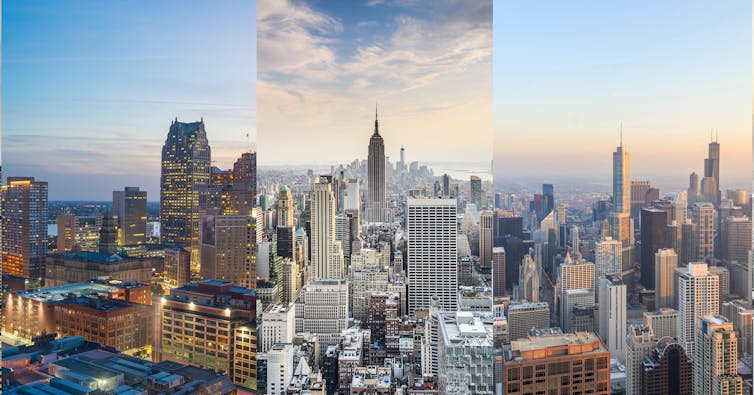What happens when black Americans leave their segregated hometowns
Black Americans who grow up in racially segregated areas tend to have worse health, education and future economic prospects. Moving out can make a big difference.

Where someone grows up is profoundly important for their life chances. It influences things like the schools they attend, the jobs, parks and community resources they have access to and the peers they interact with.
Because of this comprehensive influence, one might conclude that where you grow up affects your ability to move up the residential ladder and into a better neighborhood than the one you grew up in.
In a new study, my co-authors and I show that for many children, where they grow up is profoundly important for where they end up as adults.
But for black Americans who move away from the cities of their youth, moving out often means moving up the residential ladder.
Segregation and life outcomes
One important kind of residential disadvantage that social scientists like me are interested in is racial segregation. This generally refers to the separation of black people from white people in the neighborhoods in which they live.
Considerable research shows that living in a more racially segregated area is connected with worse outcomes for black people in a variety of areas of life, influencing everything from the probability of graduating from high school to life expectancy.
Black people remain highly segregated from white people in many areas of the United States, including Chicago, Detroit and New York. Indeed, a 2015 study found that over 50% of black people in the U.S. lived in highly segregated areas.
In other words, the majority of U.S. black people live in neighborhoods that are predominantly black and racially isolated.
These neighborhoods are often underfunded in terms of business and educational investment, distant from job opportunities and more likely to be targets for crime.
Children in these neighborhoods are at a distinct disadvantage in terms of their health, education and future economic prospects.

Growing up and moving out
Given these disadvantages, it would seem that growing up in a segregated area would have dramatic effects on a person’s life chances going forward.
For children who stay in the same place where they grew up, this seems to be the case, as my co-authors and I found in a recent study.
We looked at data from the Panel Study of Income Dynamics, a survey of 4,800 families and their descendants that began in 1968 and has continued surveying these individuals to this day.
Specifically, we looked at where black children grew up and where they lived as adults. We broke down geography by metropolitan area. Each metropolitan area generally includes a city and a number of surrounding neighborhoods, totaling 100,000 residents or more.
First, we looked at those who grew up in segregated metropolitan areas and stayed in those same areas as adults. They ended up living in more impoverished, racially isolated, lower-income neighborhoods in their adulthood, compared to children who grew up in less segregated metro areas.
However, when we turned our attention to individuals who moved out of the metro areas they grew up in, into new cities or states, we found a profoundly different set of relationships.
It didn’t matter whether a person had grown up in an area that was highly segregated or not – they lived in less impoverished and racially isolated neighborhoods as well as higher-income neighborhoods after they moved to a new metro area.
This was true regardless of their own education, income and employment status, among other characteristics.
In other words, people who leave segregated neighborhoods for new metro areas tend to move up the residential ladder, while something is keeping those who stay in the metro areas of their youth from doing so.
Why moving matters
Why do some who grow up in segregated areas end up stuck in disadvantaged neighborhoods, while those who move often end up in areas that offer more opportunities?
We accounted for individuals’ socioeconomic status in our analyses, as well as gender, marital status and characteristics of the metro area. So, this isn’t about poor people not being able to move and wealthy people being able to move – something else must be going on.
A promising potential explanation is the role of information.
When people search for housing, they tend to look to places they know a lot about already, that they have heard about from family and friends and traveled to when they go to work, the doctor or the grocery store.
This means that those who grow up in advantaged neighborhoods are more likely to explore nearby advantaged neighborhoods when they search for housing in adulthood. Meanwhile, those who grow up in disadvantaged neighborhoods may perceive those to be the primary options available to them.
This suggests some encouraging policy options that could prevent people from becoming stuck in disadvantaged areas.
For example, cities might develop programs to help prospective renters and homeowners explore new neighborhoods they might have little knowledge of. That could be a helpful way of increasing the information individuals have about new and different types of neighborhoods to move to.
Many people have limited knowledge of even relatively nearby neighborhoods that differ from those they grew up in. Such programs might allow individuals to be tourists in their own backyard.
Going forward, those interested in decreasing racial inequity may need to think about how to make sure those who want to move have information about the neighborhood options available to them.
Our findings provide encouraging suggestions that it may be possible to break the influence of segregation on children’s chances in at least one life domain: the neighborhoods they live in in adulthood.
[ Like what you’ve read? Want more? Sign up for The Conversation’s daily newsletter. ]
Partial support for this research came from a Eunice Kennedy Shriver National Institute of Child Health and Human Development research infrastructure grant, P2C HD042828, and a Eunice Kennedy Shriver National Institute of Child Health and Human Development training grant, T32 HD007543, to the Center for Studies in Demography & Ecology at the University of Washington.
Read These Next
Deception and lies from the White House to justify a war in Venezuela? We’ve seen this movie before
Two US wars based on lies, in which tens of thousands of American troops and millions of civilians died,…
Understanding climate change in America: Skepticism, dogmatism and personal experience
Real skeptics study the evidence and ask questions, rather than taking political dogma on faith. Experiencing…
Rest is essential during the holidays, but it may mean getting active, not crashing on the couch
Unwinding can be hard during the holidays for many reasons. Building in time to recharge through active…






